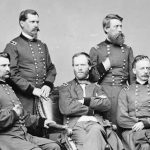 Mysteries
Mysteries  Mysteries
Mysteries  History
History 10 Surprising Stories About the Texas Rangers
 Humans
Humans 10 Philosophers Who Were Driven Mad by Their Own Theories
 Miscellaneous
Miscellaneous 10 Video-Game-Worthy Weapons and Armors from History
 Weird Stuff
Weird Stuff 10 Psychics Who Accurately Predicted Wartime Events
 The Arts
The Arts 10 Pieces of Art Inspired by a Broken Heart
 Health
Health 10 Science Fiction-Sounding New Medical Treatments
 History
History 10 Surprising Facts About the Father of Submarine Warfare
 Space
Space Ten Astonishing New Insights into Alien Worlds
 Weird Stuff
Weird Stuff 10 Bizarre Summer Solstice Rituals Still Practiced Today
 Mysteries
Mysteries Top 10 Haunting Facts About the Ghost Ship MV Alta
 History
History 10 Surprising Stories About the Texas Rangers
 Humans
Humans 10 Philosophers Who Were Driven Mad by Their Own Theories
Who's Behind Listverse?

Jamie Frater
Head Editor
Jamie founded Listverse due to an insatiable desire to share fascinating, obscure, and bizarre facts. He has been a guest speaker on numerous national radio and television stations and is a five time published author.
More About Us Miscellaneous
Miscellaneous 10 Video-Game-Worthy Weapons and Armors from History
 Weird Stuff
Weird Stuff 10 Psychics Who Accurately Predicted Wartime Events
 The Arts
The Arts 10 Pieces of Art Inspired by a Broken Heart
 Health
Health 10 Science Fiction-Sounding New Medical Treatments
 History
History 10 Surprising Facts About the Father of Submarine Warfare
 Space
Space Ten Astonishing New Insights into Alien Worlds
 Weird Stuff
Weird Stuff 10 Bizarre Summer Solstice Rituals Still Practiced Today
Ten Things You Didn’t Realize about the Vietnam War
The Vietnam War was a long, drawn-out, controversial, and very violent conflict. More than two million Vietnamese civilians were killed during the war, which was among the most violent of the second half of the 20th century. Millions of troops from both South Vietnam and North Vietnam’s respective armies died, too. Officially, nearly 60,000 American troops were killed in the fighting as well.
The U.S. spent well over $100 billion waging the war against the communist-backed North. Most notably, Vietnam dominated the news cycle and America’s foreign policy objectives alike in the years from 1965 through 1973, with considerable controversy beyond both outlying ends of that timeframe, too. The U.S. saw significant social strife over Vietnam, with anti-war activists reaching nationwide receptive audiences as citizens tired of the war machine.
But beyond all the basic storylines surrounding the Vietnam War that you learn in high school history classes, what else is there to know? Quite a lot, actually. In this list, we’ll take a long look at ten Vietnam War facts you likely didn’t realize. Unless you’re a history buff with a deep well of knowledge on this shocking and awful conflict, these ten tidbits will give you a new perspective on one of the world’s worst and most controversial recent wars.
Related: 10 Often Forgotten Battles That Helped Shape the Modern World
10 It All Started with World War II
The Vietnam War would have never happened had it not been for specific events during World War II several decades before. In fact, a full-scale conflict in Vietnam nearly broke out during World War II. In the 1940s, while on the offensive all across Asia and the South Pacific, the Japanese invaded and occupied the area which had been colonized by the French and was then known as French Indochina.
During the occupation, the Japanese found the communist-backed Viet Minh were their foes—and vicious ones at that. But like they did in many places across that region of the world at the time, Japan attempted to occupy the land for themselves, and they set upon a course of brutality to ensure it would be theirs.
Not content to let Japan have French Indochina and possibly even more land around Southeast Asia, several Allied powers and other nations stepped up to back the Viet Minh. The United States, the Soviet Union, and China all sent material and financial support to the Viet Minh in their guerrilla fight against Japan. Then, after World War II ended, the communist outfit kept that logistical support, weapons and all, and even stocked up on old Japanese weapons that the invading army had left behind upon retreat.
In turn, the Viet Minh then strongly refused French colonization once more and began a war over it. The French tried to keep a presence in the area immediately after World War II ended, but they had been depleted by the long and costly war. It didn’t help that the Soviets and the Chinese, seeing their opportunity to support a communist regime, chose to back the Viet Minh in that conflict.
In 1950, Vietnam was divided into North and South sub-sections, and the race to a full-scale civil war was on. The Soviets and Chinese supported the communist-controlled north. By 1954, the French were gone entirely, and the West feared losing the south to the communists, too. With that, the stage was set for the major showdown to come.[1]
9 Dwight’s Dominoes Determined It
In an alternate universe, it might have been enough to give Indochina to the communists, let the French leave as they wanted to do so very badly by 1954, and forget the whole matter. After all, the United States (and the rest of the world) was just coming off a hard-earned victory in World War II. That brutal conflict had been fought on two fronts by the Americans, and they shouldn’t have been so keen to start another war very soon after—or even a couple decades later, as it were.
But after World War II, something interesting happened. Communism began to take hold in Asia, first with the communist victory in China not long after the war. Then, with the Korean War having spilled blood in the early 1950s, communism found a stronghold to expand in the split-off North Korea. The U.S. and its leader at the time, Dwight D. Eisenhower, very much didn’t care to see that spread. In fact, with China and North Korea now having been toppled by communism, Eisenhower worried more countries in the region were sure to follow.
So the President put forth his Domino Theory of foreign policy. That theory held that communism was going to topple Asian countries like dominoes—one by one, down the line until all had fallen to the unwanted form of government. Within that theory, Vietnam became the centerpiece.
Determined to hold the line there, Eisenhower didn’t want communism to take over across Vietnam. If it did, he argued to his advisers and other politicians, communism would then take hold quickly in Thailand, Malaysia, Indonesia, and other Asian countries. Once its spread started in earnest, it would be impossible to stop. So Eisenhower argued in his Domino Theory that Vietnam would have to be the place where America stopped communism once and for all.[2]
8 The U.S. Limited Itself… at First
Even though President Eisenhower firmly believed in his Domino Theory as it related to the spread of communism, he knew that war wouldn’t be popular so soon after World War II and the follow-up conflict in Korea. So he opted to greatly limit the United States’ involvement in Vietnam—for a while.
Now, that didn’t mean he didn’t want to do more. At one point, he strongly considered sending in American troops to help back French fighters before that nation left the area in 1954. He also seriously considered using nuclear weapons to change the face of the Vietnamese political landscape. He decided that he’d only do that if the British joined him in fighting through the fallout, and they declined very strongly. They were too depleted after World War II and wanted no part of another offensive.
Without a reliable ally to go in on a Vietnam push with him, Eisenhower was relegated to playing the game from the sidelines. So he offered up some clandestine moves that he felt would strengthen the U.S.’ position in the region while also cutting off communism at the knees.
That meant sending in the CIA to conduct psychological warfare for a few years. It also meant offering up resources from the U.S. Navy to help evacuate refugees from North Vietnam who wanted no part of that communist regime. It wasn’t as much as what Eisenhower wanted to do, but soon enough, the operations were growing greatly in scope.[3]
7 An Aggressive Aerial Assault
After the well-known Gulf of Tonkin incident pushed the United States into outright involvement in Vietnam in 1964, the Americans didn’t hold back. While the terrain and thick jungle brush made it difficult for troops to advance great distances upon the ground, aerial assaults were the ideal method of bombing the North Vietnamese and ensuring military might would prevail (or so the Americans hoped early on, at least).
And that’s where this wild Vietnam War fact comes into play: The American aerial bombardment campaign in Vietnam was even bigger than what they rained down upon their enemies on two fronts in World War II. Across Europe and Asia combined during World War II, the Americans dropped about 2.1 million tons of explosives—including, of course, the big bombs at Hiroshima and Nagasaki.
However, in Vietnam, despite the campaign being far less involved than World War II had been, the Americans ended up dropping more than seven million tons of bombs. That’s more than a three-fold increase, and for a war that was only being fought on one front!
Of course, the rapid development of technology is partly to do with this. During World War II, planes and bomb-making technologies were relatively primitive compared to what had been developed by the time the Americans started fighting in Vietnam in late 1964.
So the fact that the U.S. had better technological tools at its disposal factored into this curious fact about the massive aerial bombardment. But still, for a conflict that was deeply unpopular at home and fought in subtle ways for years abroad via Eisenhower, the Americans really opened up the floodgates once they went in for war.[4]
6 War Crimes All Around
Sadly, there were massacres and war crimes to go around during the Vietnam War. Of course, the United States committed one of the most atrocious acts of the war when they massacred 400 innocent civilians at My Lai. It was March 16, 1968, when men, women, and children who were very much non-combatants were killed by U.S. troops in what has since become known as the My Lai Massacre.
The women were all gang-raped before the killings, too, which was an added awful tragedy on top of the unimaginable death. Even worse, the U.S. government covered up those acts in My Lai for more than a year before journalists were finally able to break the news in November 1969.
But the Americans weren’t the only guilty parties there—not by a long shot. In Vietnam at the time, the U.S.’ South Korean allies committed war crimes, too. South Korea’s 2nd Marine Brigade became infamous in its own right in 1966 when they massacred hundreds of innocent civilians at Binh Hoa and another 150 or so civilians at Binh Tai. Then, a month before the Americans would commit the My Lai atrocity, South Korean troops massacred another 80 or so civilians at Phong Ni and Phong Nat.
On the other side of the war, the Viet Cong were just as brutal. Their guerrillas made heavy use of terror tactics while fighting deep in the jungles. While specific numbers are harder to come by with them, studies estimate that as many as 80% of the casualties they caused were of people other than Allied forces and South Vietnamese troops.
In other words, four out of every five people the Viet Cong killed were innocent non-combatants. They tended to bomb refugee camps and would indiscriminately set landmines all over the place. In total, historians believe they killed hundreds of thousands of civilians, with exact numbers of their toll nearly impossible to come by at this point.[5]
5 That Awful Agent Orange
Agent Orange was infamously used by American troops as a defoliant during the war. Meant to clear away large swaths of jungle forest by poisoning and killing the trees, Agent Orange was sprayed all over the place in Vietnam. Killing the trees made it easier for the American soldiers to move about on rural, unwelcoming terrain.
But it also did more. It also snuffed out quite a few guerilla hiding places that were pocketed all over the dense jungle. By the end of the war, the United States had dropped literal tons of the chemical popularly known as Agent Orange, wiping out thousands of square miles of forest in turn. Unfortunately, it also had lasting effects that the U.S. continued to feel for decades after the fighting ended.
For one, Vietnamese people who lived through the war exhibited higher rates of various cancers than those who weren’t directly (or indirectly) exposed to the substance. Babies born after the war exhibited a greater risk of having birth defects, too. These issues were felt for decades after the war had finished. Combatants and civilians alike were forced to deal with awful health problems that were entirely of the U.S. Army’s making, often leading to premature and painful deaths.
By 2004, victims of Agent Orange had started suing the U.S. government over the manufacture and use of the product. They lost that case in court, unfortunately, but the Americans recognized they needed to do something all the same. So, along the way, the feds introduced several laws that allowed veterans to receive financial compensation and greater medical care for having fought around Agent Orange in the jungles.
Beyond that, in 2011, the U.S. and Vietnamese governments reached a formal agreement on America picking up the tab for a major decontamination project all across Vietnam. It won’t change the course of Agent Orange’s awful history, but at least it’s something.[6]
4 Tense Troops: By the Numbers
As the Vietnam War droned on down in Southeast Asia, American citizens at home were growing increasingly frustrated with the lack of progress. Many Americans were upset that the nation was even there in the first place. So it was no surprise to any observer when polls began coming out across the 1960s showing how fed up Americans were with their military.
The interesting thing, though, was that the increasing frustration with the American military strength might have coincided with some seriously cynical and depressed soldiers. It seemed as though the troops were lashing out against their own government (and themselves) as the war proved to be a deeply unpopular event.
The numbers seem to directly back that up, too. For one, enlistments in the U.S. military completely fell off the table. In 1966, more than 200,000 young Americans had joined up with the ROTC while in high school or afterward, hoping for a brighter future and content to use the military to get there. But by the time the war came down to its final years, ROTC enlistments all but dried up.
In 1974, only 30,000 young Americans joined the ROTC—or roughly one-seventh as many as those who had signed up less than a decade before. Disillusioned by Vietnam, young people stayed away. And in turn, the American military future suffered as the government increasingly struggled to replace officers who’d been killed in the war.
As for the soldiers in Vietnam during the actual conflict, they became increasingly agitated about their lives and (lack of) futures. Some units flat-out refused to go out on patrol and straight-up ignored orders from their commanders. Disillusioned at the prospect of dying for a cause they didn’t care for, they all but gave up. And then, they turned to drugs.
Per multiple sources at the time, as many as one-third of American soldiers in Vietnam regularly smoked marijuana while on duty. And even crazier was the heroin use number; upwards of 15% of all active-duty soldiers used heroin while in the Asian nation.[7]
3 Fragging Away
Sadly, some American soldiers in Vietnam escalated far beyond drug use when it came to acting out against their superiors. During the Vietnam War, a new military term was coined: “fragging.” That slang term was the shortened version of a weapon that was commonly used within the American troops’ ranks in the jungles: the fragmentation grenade. These grenades were supposed to be used to fight the enemy. But disillusioned American soldiers who were at their wits’ end with their commanders chose instead to turn the awful weapons of war upon the officers.
So fragging was when American soldiers in Vietnam would choose to purposely murder their commanding officers with the grenades. When the officers were asleep in their beds, or all within their quarters planning the next day’s actions or future assaults, an infantryman would run up with one of the frag grenades and toss it inside.
Invariably, the grenade would kill all the officers within who were going about their day. Then, when questioned, the men would lie and say that a guerrilla fighter had somehow snuck into their camp and let loose a grenade that just so happened to take out all of the officers involved.
Fragging sounds like a terrible way to die, and it was. It was also a terrible act to commit on one’s own fellow soldiers. But low-level infantrymen were sick of fighting the war and tired of doing as their overzealous commanding officers said. So they took terrible and tragic actions against them. Between 1969 and 1971 alone, journalists and war historians have documented hundreds of cases of fragging in which superior officers were killed by their own men who had been long since fed up with battle.[8]
2 Fighting Far Beyond Vietnam
While it was named the Vietnam War, and while it certainly started within Vietnam way back during the French Indochina days, fighting was not limited to that country alone. In total, eight countries were involved in the battle in one way or another. And actual, tangible fighting took place in two other nations next door to Vietnam: Laos and Cambodia.
Even as early as 1964, the United States was secretly bombing Laos in an effort to keep communism from expanding to that nation, too. The Americans didn’t want a full-scale offensive within Laos, but they also didn’t want communism to keep expanding (recall the Domino Theory from above). Thus, they decided their best course of action was to bomb Laos, trust that the attacks were coordinated enough to keep insurgents at bay, and hope for the best.
Meanwhile, in Cambodia, the Americans began secretly bombing that nation as well in 1969. Those bombs were released over Cambodia for much the same motives as had previously been done in Laos, so the Americans figured they’d probably have a similar situation to deal with there. However, by 1970, the situation had become serious enough that the United States actually sent in ground troops to fight in Cambodia. Never mind that the Cambodians were officially neutral in the war—troops stormed into their borders to fight anyway.[9]
1 Vietnamization for Vietnam
The Vietnam War began with a policy handed down from Washington—Dwight D. Eisenhower’s Domino Theory—so why not end it with one, too? Starting in 1970, Americans and other Allied forces began withdrawing en masse from the everyday fighting in Vietnam. In their place, South Vietnamese soldiers remained to fight against the Viet Cong in the north.
But the Americans didn’t quite leave the south empty-handed. Instead of backing them with actual troops, the U.S. simply started providing financial and logistical support alone for their ally. South Vietnamese troops had to carry out all frontline combat duties while Americans backed them with the big bucks, the expensive equipment, and the technical know-how.
This became known as the policy of Vietnamization. It was a move made to get American forces out of the war and put the country back into the hands of the factions who were fighting over it. (While the U.S. government could still feel as though they were subtly putting their thumb on the scale, of course.) Of course, Vietnamization didn’t work like the Americans had hoped.
Beginning after 1970, the North started winning nearly every battle fought in the war. And after 1973, their record in battles with the South was nearly perfect. By 1975, those victories had piled up, and the whole thing was over. The U.S. had pulled out, the French were long gone, the South was in shambles, and the North had won. Vietnamization—and the overall Domino Theory push into Vietnam—had been a complete and utter failure.[10]








